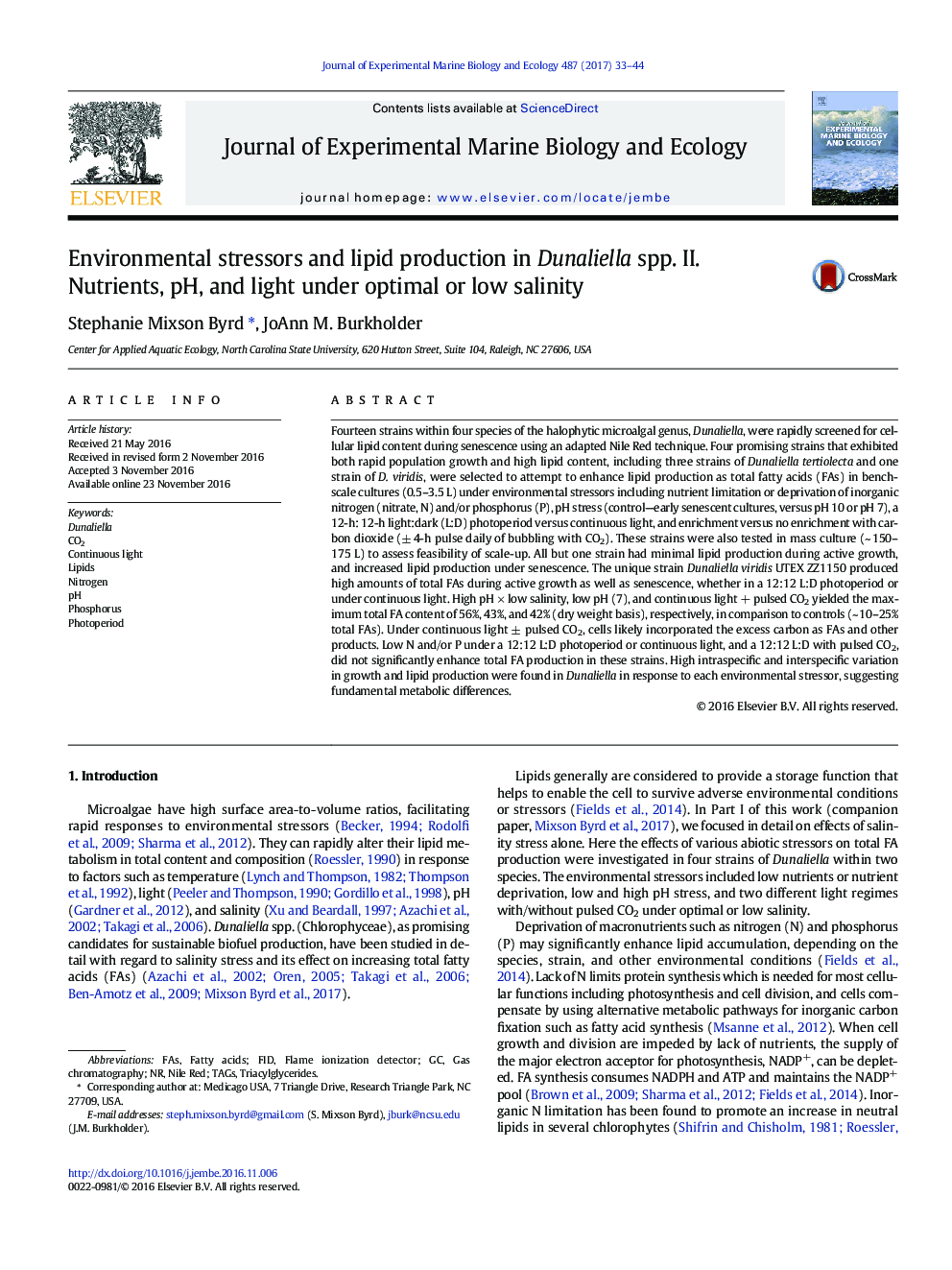| کد مقاله | کد نشریه | سال انتشار | مقاله انگلیسی | نسخه تمام متن |
|---|---|---|---|---|
| 5744577 | 1618388 | 2017 | 12 صفحه PDF | دانلود رایگان |

- Fourteen strains within four species of the halophytic microalgal genus, Dunaliella were rapidly screened for cellular lipid content during senescence using an adapted Nile Red technique. Four promising strains that exhibited both rapid population growth and high lipid content, including three strains of Dunaliella tertiolecta and one strain of D. viridis, were selected to attempt to enhance lipid production as total fatty acids (FAs) under environmental stressors including nutrient limitation or deprivation of inorganic nitrogen (nitrate, N) and/or phosphorus (P), pH stress (control - early senescent cultures, versus pH 10 or pH 7), a 12-h: 12-h light:dark (L:D) photoperiod versus continuous light, and enrichment versus no enrichment with carbon dioxide (± 4-hr pulse daily of bubbling with CO2).
- All but one strain had minimal lipid production during active growth, and increased lipid production under senescence. The unique strain Dunaliella viridis UTEX ZZ1150 produced high amounts of total FAs during active growth as well as senescence, whether in a 12:12Â L:D photoperiod or under continuous light.
- High pHÂ ÃÂ low salinity, low pH (7), and continuous light + pulsed CO2 yielded the maximum total FA content of 56%, 43%, and 42% (dry weight basis), respectively, in comparison to controls (~Â 10 to 25% total FAs). Low N and/or P under a 12:12Â L:D photoperiod or continuous light, and a 12:12Â L:D with pulsed CO2, did not significantly enhance total FA production.
Fourteen strains within four species of the halophytic microalgal genus, Dunaliella, were rapidly screened for cellular lipid content during senescence using an adapted Nile Red technique. Four promising strains that exhibited both rapid population growth and high lipid content, including three strains of Dunaliella tertiolecta and one strain of D. viridis, were selected to attempt to enhance lipid production as total fatty acids (FAs) in bench-scale cultures (0.5-3.5 L) under environmental stressors including nutrient limitation or deprivation of inorganic nitrogen (nitrate, N) and/or phosphorus (P), pH stress (control-early senescent cultures, versus pH 10 or pH 7), a 12-h: 12-h light:dark (L:D) photoperiod versus continuous light, and enrichment versus no enrichment with carbon dioxide (± 4-h pulse daily of bubbling with CO2). These strains were also tested in mass culture (~ 150-175 L) to assess feasibility of scale-up. All but one strain had minimal lipid production during active growth, and increased lipid production under senescence. The unique strain Dunaliella viridis UTEX ZZ1150 produced high amounts of total FAs during active growth as well as senescence, whether in a 12:12 L:D photoperiod or under continuous light. High pH Ã low salinity, low pH (7), and continuous light + pulsed CO2 yielded the maximum total FA content of 56%, 43%, and 42% (dry weight basis), respectively, in comparison to controls (~ 10-25% total FAs). Under continuous light ± pulsed CO2, cells likely incorporated the excess carbon as FAs and other products. Low N and/or P under a 12:12 L:D photoperiod or continuous light, and a 12:12 L:D with pulsed CO2, did not significantly enhance total FA production in these strains. High intraspecific and interspecific variation in growth and lipid production were found in Dunaliella in response to each environmental stressor, suggesting fundamental metabolic differences.
Journal: Journal of Experimental Marine Biology and Ecology - Volume 487, February 2017, Pages 33-44